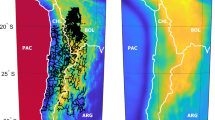Summary
Basically two different evaluation methods are available to compute geoid heights from residual gravity anomalies in the inner zone: numerical integration and least squares collocation.
If collocation is not applied to a global gravity data set, as is usually the case in practice, its result will not be equal to the numerical integration result. However, the cross covariance function between geoid heights and gravity anomalies can be adapted such that the geoid contribution is computed only from a small gravity area up to a certain distanceψ o from the computation point. Using this modification, identical results are obtained as from numerical integration.
Applying this modification makes the results less dependent on the covariance function used. The difference between numerical integration and collocation is mainly caused by the implicitly extrapolated residual gravity anomaly values, outside the original data area. This extrapolated signal depends very much on the covariance function used, while the interpolated values within the original data area depend much less on it.
As a sort of by-product, this modified collocation formula also leads to a new combination technique of numerical integration and collocation, in which the optimizing practical properties of both methods are fully exploited.
Numerical examples are added as illustration.
Similar content being viewed by others
References
Haagmans R., E. de Min, M. van GelderenFast evaluation of convolution integrals on the sphere using 1D FFT, and a comparison with existing methods for Stokes' integral manuscripta geodaetica Vol.18, pp.227–241, 1993
Heck B., W. GrüningerZur Genauigkeit gravimetrisch bestimmter absoluter und relativer Geoidhöhen Deutsche Geodätische Kommission, Reihe A, Heft Nr.97, 1983
Heiskanen W.A., H. MoritzPhysical geodesy W.H. Freeman and Company, San Fransisco, 1967
Holota P., M. Vermeer (eds)Proceedings of First Continental Workshop on the Geoid in Europe Prague, May 11–14, 1992
Kearsley A.H.W.Data requirements for determining precise relative geoid heights from gravimetry Journal of Geophysical Research, Vol. 91, No. B9, pp.9193–9201, 1986
Knudsen P.Estimation and modelling of the local empirical covariance function using gravity and satellite altimeter data Bulletin Géodésique, 61, pp.145–160, 1987
Lachapelle G.Estimation of disturbing potential components using a combined integral formulae and collocation approach manuscripta geodaetica Vol.2, pp.233–262, 1977
Lambert W.D., F.W. DarlingTables for determining the form of the geoid and its indirect effect on gravity Special publication No 199, U.S. Department of Commerce, 1936
Min E. deA comparison of three geoid computation methods Proceedings of session G3 — European Geophysical Society XVIII General Assembly, Wiesbaden, Germany, May 3–7, 1993
Moritz H.Integral formulas and collocation manuscripta geodaetica Vol.1, pp.1–40, 1976
Moritz H.Advanced Physical Geodesy Wichmann, Karlsruhe, 1980
Paul M.K.A method of evaluating the truncation error coefficients for geoidal height Bulletin Géodésique, 110, pp.413–425, 1973
Sevilla M.J., G. Rodriguez-Caderot, A.J. GilAnalysis of the Medigeo92, a gravimetric geoid in the Mediterranean Sea Proceedings of session G3 — European Geophysical Society XVIII General Assembly, Wiesbaden, Germany, May 3–7, 1993
Author information
Authors and Affiliations
Rights and permissions
About this article
Cite this article
de Min, E. A comparison of Stokes' numerical integration and collocation, and a new combination technique. Bulletin Géodésique 69, 223–232 (1995). https://doi.org/10.1007/BF00806734
Received:
Accepted:
Issue Date:
DOI: https://doi.org/10.1007/BF00806734




